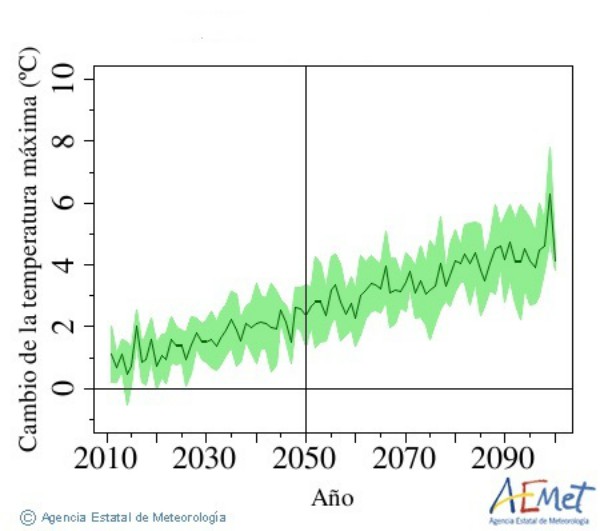Some people still doubt that our planet is getting warmer, but growers and winemakers in Rioja aren’t among them. In a recent study carried out by sociologists Sergio Andrés Cabello and Joaquín Giró of the University of La Rioja, 90% of the 481 growers and winemakers surveyed believe that climate change is a reality. 65% feel that its effects will be negative or very negative and 46% think that Rioja will have to adapt to new circumstances.
This study revealed that between 1950 and 2014, the average temperature in the Rioja region increased between 0,9ºC and 1,2ºC (1,6ºF-2,2ºF).
Another study carried out by the Spanish Meteorology Agency predicts that at the current rate of increase, by 2050, the maximum temperature will be 4ºC higher than its 2010 level.
The 2023 weather forecast for a long, extraordinarily hot summer seems to bear out this prediction.
Graph from AEMET (The Spanish Meteorology Agency) via blogriojaalavesa.eus
The impact of higher temperatures and less rainfall in the DOCa Rioja
Higher temperatures and less rainfall have impacted the harvest in Rioja in several ways. First, the growth cycle of the grapes (flowering, véraison and the date of the harvest) take place around 8 to 10 days earlier in the year than in the past. In the future, warmer weather in September and October may not create the high temperature differential between day and night for the grapes to ripen properly.
Warmer temperatures create problems in deciding the optimum time to pick due to an imbalance between the sugar/acidity level and the phenolic compounds responsible for color and texture in the finished wine.
To pick when the potential alcohol in the grapes is 12 or 13%, the level of phenolic compounds that produce color and texture is too low. On the other hand, waiting until these phenolic compounds are at an optimum level means that the potential alcohol in the grapes can be as high as 15 to 16%.
Fernando Martínez de Toda, chair of the Department of Viticulture at the University of La Rioja suggests several possible ways farmers can mitigate the effects of climate change. Some of these changes include:
—delaying the ripening of the grapes by planting new vineyards at higher altitude,
—prioritizing planting grapes with longer growth cycles such as graciano and garnacha,
—using late-ripening clones,
—severely cutting back leaf canopies,
—late pruning and even forcing a second budbreak.
Some of these methods can be implemented at little cost to growers. Others, such as planting at higher altitude, require heavy investment and will probably mean long debates among the members of the Rioja Regulatory Board, the body responsible for approving changes in the boundaries of the Rioja Designation.
How is climate change affecting tempranillo, Rioja’s star varietal?
A study of the long-term evolution of Rioja vineyards carried out by the Basque Institute of Research and Agrarian Development postulated that with the abovementioned 4ºC increase in temperature, an increase in carbon dioxide and a decrease in relative humidity to 12%, grapes from Rioja vineyards would produce juice with less color (a sign of lower quality according to today’s standards) and an increase in pH (lower acidity), causing the wines to lack crispness and texture.
Tempranillo, a varietal with low acidity that even today leads winemakers to add acid to lower pH (the lower the pH, the higher the acidity level), would be especially affected. Because tempranillo’s growth cycle is shorter than other varieties, it would bear the full impact of higher daytime temperatures without benefiting from a cooler nighttime.
Despite these warnings and the potential investments that may be required to deal with increasing temperature and less rainfall in Rioja, Fernando Martínez de Toda is optimistic, at least in the short and medium term. He says, “Global warming has been mostly positive for Rioja”.
In the past, in Rioja Alta and Rioja Alavesa, grapes were picked just after veraison with only 10 or 11% potential alcohol.
Traditionally, these wines were blended with grapes and wine from vineyards in the warmer, drier Rioja Oriental that produced wines with a much higher strength. The resulting blends had 12 to 12,5% alcohol.
Today warmer temperatures allow grapes at higher altitude and in cooler parts of Rioja such as Rioja Alta and Rioja Alavesa to ripen fully.
The Rioja Regulatory Board creates a Sustainability Experts’ Committee
Rioja is trying to anticipate future events by creating a Sustainability Experts’ Committee. Its aim is to assess the impact of changing climate conditions and to suggest measures to mitigate their effects, applying a holistic view of sustainability by analyzing the environmental, socioeconomic and governance impacts produced by climate change.
Leading the project are Estíbaliz Torrealba, the coordinator of the Sustainability Experts group and Helena Fernández, a partner and director of Sustainability and Climate Change at Isemaren, a consulting company specializing in green investment and the global transition.
The first phase of the project determined and identified almost 200 measurable variables and indicators, while phase two, about to begin, involves randomly selected wineries and grape farmers. These participants will provide information that will allow the project coordinators to assess the state of sustainability in the DOCa Rioja.
With this empirical information, all involved in the Rioja business are taking steps to face the future with the tools to mitigate its effects effectively and confidently.
Text by Tom Perry, Inside Rioja
Learn more about Bilbao-Rioja Great Wine Capitals
